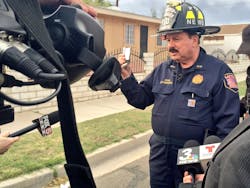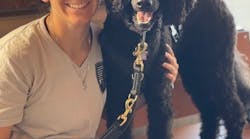I started my fire service career 46 years ago when an aircraft crashed into my backyard and caught fire. I had just graduated from high school in Ohio and was a member of the Civil Air Patrol’s Search & Rescue team, which was well known in our community. One of our duties was to protect the scene of aircraft crashes until the FAA arrived to investigate. During this incident, the fire chief for our town walked over and asked me if I would be interested in joining the fire department. A month later I was a member and went on to become their first certified EMT and paramedic. A few years later, after the purchase of the first two department ambulances, I became the EMS coordinator.
In 1978, I moved to metro Atlanta and was a firefighter with the Gwinnett County Fire Department. Over the next 5 years, I served as an EMT on the Rescue, an engineer and a company officer.
In 1983, the assistant chief asked me to take a temporary transfer from company officer to headquarters to assist our new fire chief. He was not from our department and was unfamiliar with the area. I was to serve as his aide for 30 days and then go back to my company. After those 30 days, I was told they needed me in this capacity a little while longer. One day the new chief called me into his office and asked if I would be interested in dealing with the news media. He said he heard a new term being used, public information officer, and asked if I would consider being the spokesperson for the department. I was taught never to turn down a chance to try something new, so I accepted. Little did I know this would become my career in the fire service.
In 1987, I accepted a position as fire chief in Winder, GA. I loved my job as fire chief, but I regularly thought about how much I missed being a PIO and working with the media. When I was offered the opportunity in 1992 to become the PIO for the Atlanta Fire Rescue Department and serve as their PIO at the 1996 Olympics, I knew I could not pass up the chance to hold this position at the largest media event in peacetime history.
Throughout my career, I subscribed to several different fire publications. The one I always look forward to the most was Firehouse because it is the one magazine that represents the average, everyday firefighter. It has action photos, columns that are interesting, and ads of things that firefighters are looking for and want to buy. It relates to both volunteer and professional firefighters alike.
As PIO for Atlanta Fire Rescue, I started sending Firehouse my media releases. Atlanta was already on the national media radar because of the1996 Centennial Olympics preparations when a fire at the Atlanta/Fulton County Stadium caught their attention. One day after the stadium fire, Harvey Eisner, editor-in-chief of Firehouse, called and introduced himself. He asked if I was familiar with Firehouse. I told him I was a subscriber since the first issue in 1976. He then asked if I was familiar with an article that ran from time to time called On The Job, a feature on large incidents and the fire department that handled the job. Harvey asked me to write an article about the stadium fire. I couldn’t believe it. My first chance to write an article for, what I considered to be, the premier fire publication in circulation.
I wrote the article, made arrangements for photos, and it was published in the January 1994 issue. In November 1995, Harvey ask me to write another article about the new 9-1-1 dispatch center in Atlanta in anticipation of the summer Centennial Olympics there. That article was published in January 1996.
Just before the ’96 Olympics, the City of Las Vegas called and asked if I would consider being the first PIO for Las Vegas Fire & Rescue. I had never been to Las Vegas, so they flew me out to see the city and tour the department. For the first time in my career, people were asking me to work for them instead of me asking them for a job. I felt like a professional athlete in demand when they asked, “What will it take for you to accept the job?” They made me an offer, and in July, on the day after the closing ceremony of the Olympics, I moved to Las Vegas with my family.
Harvey and I were in contact more often after I moved to Las Vegas. He asked a fire inspector from our department to write an article about the “Stratosphere Tower,” which had just opened. Harvey came to Las Vegas to do an interview with the inspector and go on a tour of the Stratosphere. This was the first time we met and the first of many times I would spend with Harvey in Las Vegas and at Firehouse and other Fire/EMS conferences.
During the 2000s, I was a guest columnist with a variety of columns, mostly about public information or public education. Being a PIO is a demanding position. You are on duty all the time. When the crews go back to the station after a fire is when the PIO is the busiest. The media wants information, and some incidents may take hours, days or weeks to handle. Because of my experience at several departments and working in so many different capacities, it gave me an insight on how things work in the fire service. You can tell the story better if you know how it works, and Firehouse offered me a way to share this experience with others who were learning to work with the media. Harvey also asked me to do classes at Firehouse conferences in Baltimore, San Diego and in Las Vegas about being a PIO.
I continued to send Firehouse my media releases, and usually each month there was a small column with a line or two about various large incidents (Fire Wire) and many times information from my media releases would show up in there.
After Harvey published WTC: In Their Own Words, which was a 10th Anniversary Special Collector’s Edition about 9/11, he was featured on some local Las Vegas TV shows so I met and escorted him to the various media outlets.
In 2012, I started writing articles about public information and public education more routinely, mostly once each month. During this time I had the pleasure to work with Jeff Barrington, associate publisher. He would ask for a certain type of article and I would write it. Articles were written to benefit everyone from the large paid professional department to the small volunteer department. It does not matter what size or type of department you are, public information and public education are two areas that all types of departments need to know about and practice.
Sometimes Firehouse would ask for photographs. I have an extensive library of photos, and many times I had what they needed. In 2013, Harvey called and asked if I wanted to submit a photo for a new book he was working on—Firehouse Collector’s Edition Hot Shots – Spectacular Fire Photos. I was honored he selected a photo I took of our equipment working a three-alarm fire on the Las Vegas Strip.
After the passing of Harvey, I started working with Editor-in-Chief Tim Sendelbach and Executive Editor Janelle Foskett. Tim is a friend and we have known each other for several years. I continued to submit articles mostly about public information. Now, with social media a part of our lives, many of my articles are about how social media affects and can be used by the fire service.
I also use Firehouse as a teaching aid. For the past 20 years, I have conducted a Citizens Fire Academy in Las Vegas. Citizens attend a 3-hour class, once a week for 10 weeks, to learn what the fire service is all about and how their fire department operates. Each participant is given a notebook full of maps, information sheets, fire prevention material and other handouts. I always include a copy of Firehouse with each notebook. I tell the class that the magazine is so well done that they can look it over and get a feel of what firefighting is all about.
In 2015, my name was added to the inside cover of Firehouse as a contributing editor for the magazine. I have received several recognitions and awards, some national, in my career, but nothing has meant more to me than seeing my name in the list of contributing editors. Little did I know when I first subscribed to Firehouse in 1976 and enjoyed it so much that years later I would be a part of the team that produces the best fire service magazine ever printed!
Things come and go over time. For the past 40 years Firehouse has helped the fire service stay informed with news and training. I wish Firehouse the best of luck and continued success for the next 40 years.






